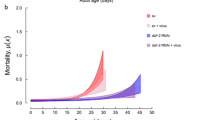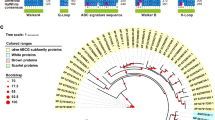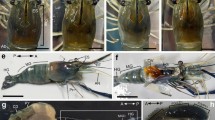Abstract
We propose that a shut-down in expression of ribosomal protein S2 (rpS2) contributes to regulation of diapause in adult females of Culex pipiens. While this gene is expressed continuously in nondiapausing females reared under long-day conditions, it is strongly down-regulated 5–18 days after adult eclosion in females reared under the short-day conditions that induce diapause. The possibility that this shut-down in expression of rpS2 contributes to the arrest in ovarian development characteristic of diapause is bolstered by the diapause-like arrest in follicle growth observed when nondiapausing females are injected with dsrpS2. A control gene encoding another ribosomal protein, L19, is expressed equally in nondiapausing and diapausing females, and RNA interference directed against rpL19 did not arrest follicle growth, thus indicating that the response we observed in knocking down expression of rpS2 is not common to all ribosomal proteins. Diapause in C. pipiens is readily terminated with juvenile hormone (JH), and in this study we demonstrated that an exogenous application of JHIII can rescue the arrest in follicle growth caused by dsrpS2. Together, these results suggest that rpS2 plays a critical role in arresting the ovarian development associated with diapause in this mosquito.





Similar content being viewed by others
References
Brandhorst BP (1985) Informational content of the echinoderm egg. In: Browder LW (ed) Developmental Biology A comprehensive synthesis, vol 1, Oogenesis. Plenum Publishing Co., New York, pp 525–576
Byrom M, Pallotta V, Brown D, Ford L (2002) Visualizing siRNA in Mammalian cells: fluorescence analysis of the RNAi effect. Ambion TechNotes 9:68
Christophers SR (1911) The development of the egg follicle in Anophelines. Paludism 1:73–88
Clements AN, Boocock M (1984) Ovarian development in mosquitoes: stages of growth and arrest, and follicular resorption. Physiol Entomol 9:1–8
Cramton SE, Laski FA (1994) String of pearls encodes Drosophila ribosomal protein S2, has Minute-like characteristics, and is required during oogenesis. Genetics 137:1039–1048
Davidson E (1976) Gene activity in early development. Academic Press, New York
Denlinger DL (2002) Regulation of diapause. Annu Rev Entomol 47:93–122
Denlinger DL, Yocum GD, Rinehart JP (2005) Hormonal control of diapause. In: Gilbert LI, Iatrou K, Gill SS (eds) Comprehensive molecular insect science, vol 3. Elsevier Pergamon, Oxford, pp 615–650
Dorn G, Patel S, Wotherspoon G, Hemmings-Mieszczak M, Barclay J, Natt FJC, Martin P, Bevan S, Fox A, Ganju P, Wishart W, Hall J (2004) siRNA relieves chronic neuropathic pain. Nucleic Acids Res 32:e49
Hemmings-Mieszczak M, Dorn G, Natt FJ, Hall J, Wishart WL (2003) Independent combinatorial effect of antisense oligonucleotides and RNAi-mediated specific inhibition of the recombinant Rat P2X3 receptor. Nucleic Acids Res 31:2117–2126
Hyman LE, Wormington WM (1988) Translational inactivation of ribosomal protein mRNAs during Xenopus oocyte maturation. Genes Dev 2:598–605
Kim M, Robich RM, Rinehart JP, Denlinger DL (2006) Upregulation of two actin genes and redistribution of actin during diapause and cold stress in the northern house mosquito, Culex pipiens. J Insect Physiol 52:1226–1233
Kim M, Sim C, Denlinger DL (2009) RNA interference directed against ribosomal protein S3a suggests a link between this gene and arrested ovarian development during adult diapause in Culex pipiens. Insect Mol Biol (in press)
King RC (1970) Ovarian development in Drosophila melanogaster. Academic Press, New York
LaMarca MJ, Wassarman PM (1979) Program of early development in the mammal: changes in absolute rates of synthesis of ribosomal proteins during oogenesis and early embryogenesis in the mouse. Dev Biol 73:103–119
Maquire BA, Zimmermann RA (2001) The ribosome in focus. Cell 104:813–816
Niu LL, Fallon AM (1999) The ribosomal protein L34 gene from the mosquito, Aedes albopictus: exon–intron organization, copy number, and potential regulatory elements. Insect Biochem Mol Biol 29:1105–1117
Niu LL, Fallon AM (2000) Differential regulation of ribosomal protein gene expression in Aedes aegypti mosquitoes before and after the blood meal. Insect Mol Biol 9:613–623
Patel R, Jacobs-Lorena M (1992) Generation of Minute phenotypes by a transformed antisense ribosomal protein gene. Dev Genet 13:256–263
Postlethwait JH, Giorgi F (1985) Vitellogenesis in insects. In: Browder LW (ed) Developmental biology: a comprehensive synthesis, vol 1, Oogenesis. Plenum Press, New York, pp 85–119
Qian S, Hongo S, Jacobs-Lorena M (1988) Antisense ribosomal protein gene expression specifically disrupts oogenesis in Drosophila melanogaster. Proc Natl Acad Sci USA 85:9601–9605
Raikhel AS (1992) Vitellogenesis in mosquitoes. Adv Dis Vector Res 9:1–39
Readio J, Meola R (1985) Two stages of juvenile hormone-mediated growth of secondary follicles in Culex pipiens. J Insect Physiol 31:559–562
Readio J, Chen MH, Meola R (1999) Juvenile hormone biosynthesis in diapausing and nondiapausing Culex pipiens (Diptera: Culicidae). J Med Entomol 36:355–360
Ringer S (1883) A further contribution regarding the influence of the different constituents of the blood on the contraction of the heart. J Physiol 4:29–42
Robich RM, Denlinger DL (2005) Diapause in the mosquito Culex pipiens evokes a metabolic switch from blood feeding to sugar gluttony. Proc Natl Acad Sci USA 102:15912–15917
Robich RM, Rinehart JP, Kitchen LJ, Denlinger DL (2007) Diapause-specific gene expression in the northern house mosquito. Culex pipiens L., identified by suppressive subtractive hybridization. J Insect Physiol 53:235–245
Sanburg LL, Larsen JR (1973) Effect of photoperiod and temperature on ovarian development in Culex pipiens pipiens. J Insect Physiol 19:1173–1190
Sanyal SC, Liljas A (2000) The end of the beginning: structural studies of ribosomal proteins. Curr Opin Struct Biol 10:633–636
Sim C, Denlinger DL (2008) Insulin signaling and FOXO regulate the overwintering diapause of the mosquito Culex pipiens. Proc Natl Acad Sci USA 105:6777–6781
Sim C, Hong YS, Tsetsarkin KA, Vanlandingham DL, Higgs S, Collins FH (2007) Anopheles gambiae heat shock protein cognate 70B impedes o’nyong-nyong virus replication. BMC Genomics 8:231
Spielman A, Wong J (1973a) Studies on autogeny in natural populations of Culex pipiens. III. Midsummer preparation for hibernation in anautogenous populations. J Med Entomol 10:319–324
Spielman A, Wong J (1973b) Environmental control of ovarian diapause in Culex pipiens. Ann Entomol Soc Am 66:905–907
Wool IG (1993) The bifunctional nature of ribosomal proteins and speculations on their origins. In: Neirhaus KH (ed) The translational apparatus. Plenum Press, New York
Zurita M, Reynaud E, Kafatos FC (1997) Cloning and characterization of cDNAs preferentially expressed in the ovary of the mosquito, Anopheles gambiae. Insect Mol Biol 6:55–62
Acknowledgments
Thanks to Dr. Lyrie Bartholomay (Iowa State University) for providing tips on using the neutral red staining techniques. Hyeri Lee assisted in extracting some of the RNA samples. This study was supported in part by NIH grant R01-AI058279.
Author information
Authors and Affiliations
Corresponding author
Additional information
Communicated by H.V. Carey.
Rights and permissions
About this article
Cite this article
Kim, M., Denlinger, D.L. A potential role for ribosomal protein S2 in the gene network regulating reproductive diapause in the mosquito Culex pipiens . J Comp Physiol B 180, 171–178 (2010). https://doi.org/10.1007/s00360-009-0406-9
Received:
Revised:
Accepted:
Published:
Issue Date:
DOI: https://doi.org/10.1007/s00360-009-0406-9




